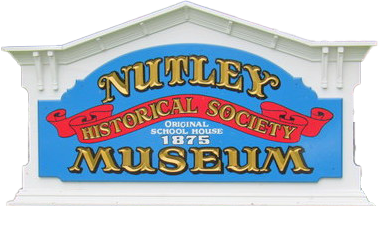Battery A, 98th Antiaircraft Artillery Battalion
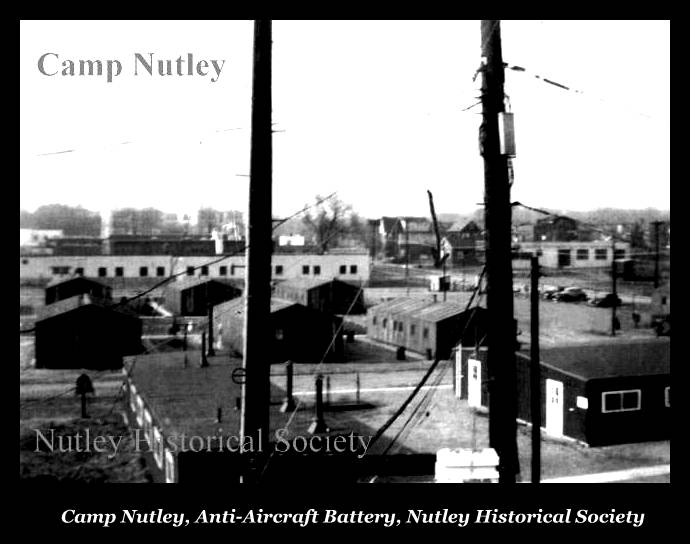
"We Were Ready"
Soldiers camped in Nutley set to fend threat of Cold War foreign bombers
From 1952 to 1957 the U.S. Army had anti-aircraft gun bases in our area to defend the George Washington Bridge from aerial attack (presumably from Russian bombers likely attacking from the north via the North Pole route) thus knocking out much of our trans-Hudson River transportation.
These bases were scattered on both sides of the Hudson River and locally were near Newark Airport, up in Belleville Park and right here in Nutley near the Passaic River where the current ball fields, tennis courts and hockey rink stand today.
The Nutley base, site of Battery A of the 98th Antiaircraft Gun Battalion, known locally as "Camp Nutley", was some 11 miles from the bridge and its four 90mm guns could fire up to 22 projectiles/minute/gun, radar-guided and capable of being detonated near a target.
Nutley and the Nutley Historical Society dedicated a plaque on the premises where the base stood (on Park Avenue across from Parks and Rec building, near the parking lot).
A presentation by the commander was held at the Nutley Museum that same evening. The memorial is located south of the hockey rink, up a short rise.
U.S. Army Anti-Aircraft Battery Video Debuts at Nutley Historical Society
April 19, 2017
Nutley Historical Society will present an encore discussion and new video produced by Retired Lt. Col. Walter Debany (son of former camp commander Michael Debany) detailing the History of US Army "Camp Nutley," officially known as Battery A of the 98th AAA Air Defense Battalion.
Camp Nutley, Battery A, 98th AAA Gun Battalion: I Was There
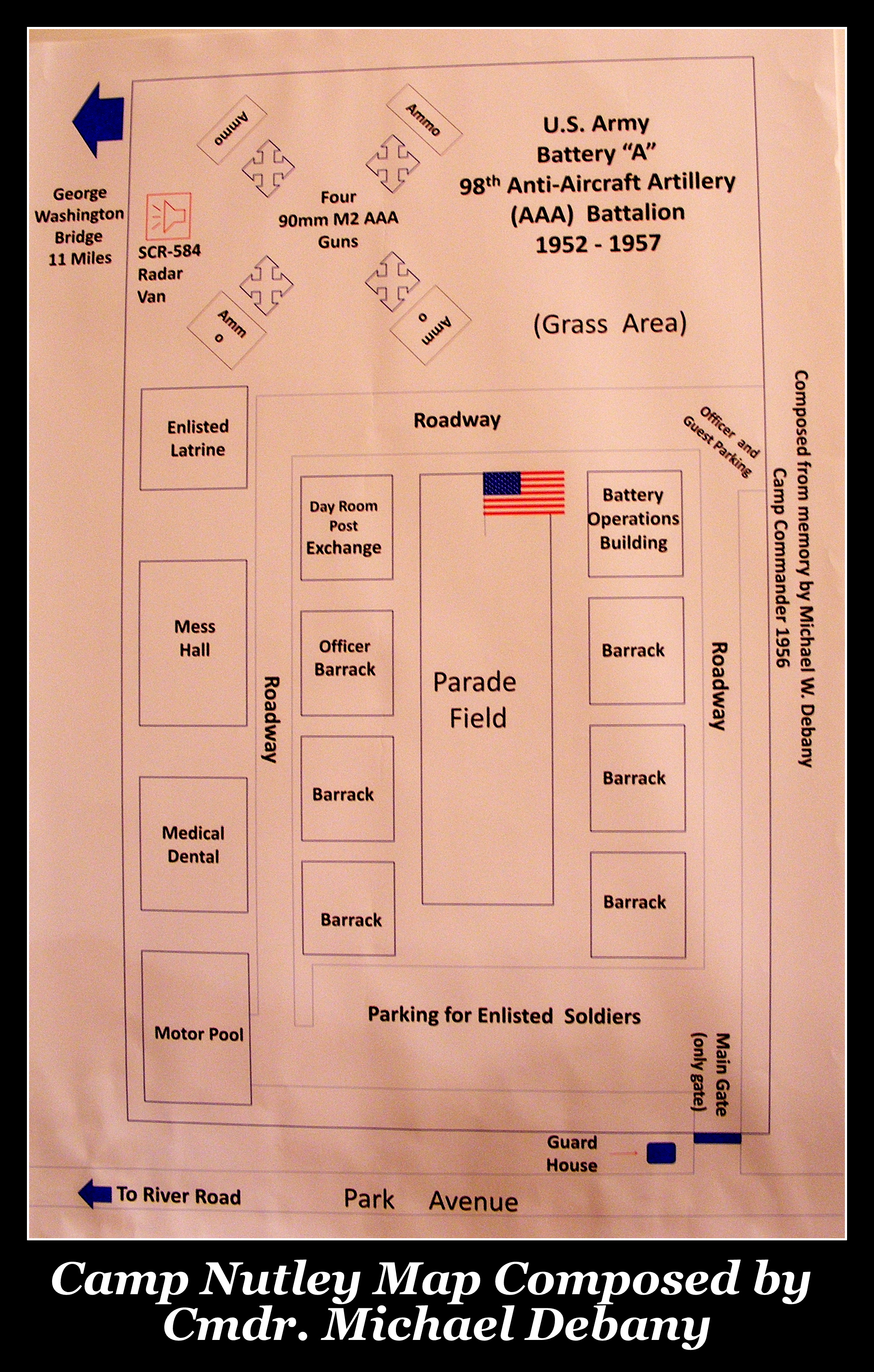
Help us to tell the full story of “Camp Nutley.”
US Army "Camp Nutley" aka Battery A of the 98th AAA Air Defense Battalion
Did you, or someone you know, serve in Nutley at Battery A of the 98th AAA Air Defense Battalion form 1952 to 1957?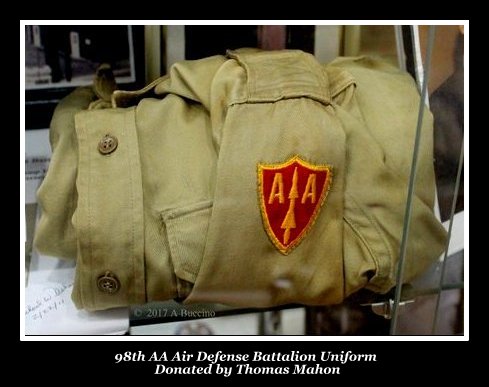
The Nutley History Society is seeking former members and artifacts of this chunk of Nutley history in protecting the free world.
Share your story and preserve our history by sharing your tales of serving at the camp. Please call us at 973-667-1528 and leave your contact information.
The camp was located on the south side of Park Avenue near Route 21 where the ball fields, tennis courts and hockey rink stand today. Its four 90 MM radar controlled guns were assigned to defend the George Washington Bridge, just 11 miles away, from Soviet bomber attack.
AA shirt donated to the Nutley Museum by current Nutley resident and former Camp Clerk Thomas Mahon.
Visit the Nutley Museum and see our Camp Nutley exhibit.
The History of 'Camp Nutley' Anti-Aircraft Army Base
By Barry Lenson
Of the many amazing stories about Nutley’s past, the most incredible of all could be the history of “Camp Nutley,” an anti-aircraft artillery base that was in full operation in Nutley between 1952 and 1957. The camp, officially called U.S. Army 98th AAA Gun Battalion, Battery A, was home to at least 100 soldiers at all times. It occupied four acres on Park Street, across from what is now the Nutley Parks and Recreation building.
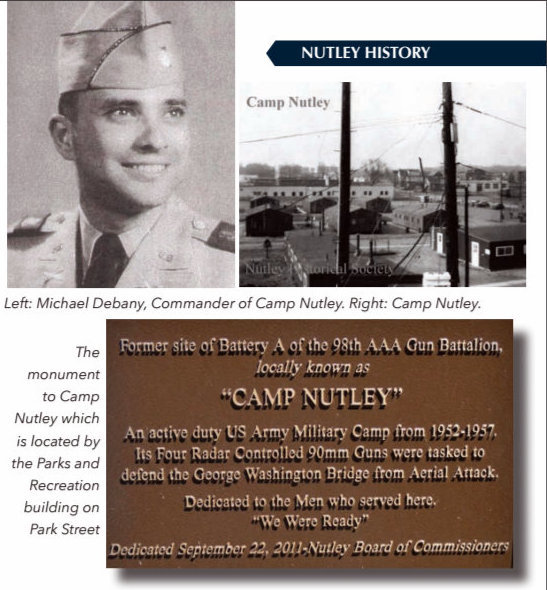
Camp Nutley was a fully functioning Army base. There were barracks, a mess hall, back-up electrical generators, a motor pool and – most important of all - four big 90 millimeter M2 anti-aircraft guns that were capable of firing 20 rounds per minute. According to Michael W. Debany, a great friend of Nutley who was Commander in Chief of the base, shells could be fired a distance of 17 miles.
What Were those Big Guns Aiming At?
Why was the base here? What important target was located within 17 miles of our town? If you guessed New York City, you are on the right track. But the purpose of the base was to shoot down Soviet bombers if they few into our area to destroy the George Washington Bridge. Any Soviet planes could be shot down by shells fired from Nutley and from several other artillery installations located near the Hudson River.
Picking Soviet planes out of the sky at a distance of 17 miles would not have been easy. According to Michael Debany, his soldiers engaged in daily practice drills to keep their skills sharp. The base’s Radar Platoon monitored air traffic 24 hours a day. Top Army brass made regular visits to conduct inspections and twice a year, the Nutley guns were trucked to Montauk on the tip of Long Island, where our artillerymen practiced blowing floating targets out of the water.
As Commander Debany wrote in a memoir that he prepared for the Nutley Historical Society, “We were designated by the Army as a ‘combat ready unit.’ I can tell you from being there . . . we were ready!”
Reprinted from Nutley Neighbors, April 2017; Best Version Media
A community magazine serving the residents of Nutley, N.J.
Camp Nutley - aka Camp Avondale
The Plastic Helmet ARAACOM: Army Antiaircraft Command
By Nick R. Homyak
Remembering Camp Nutley or Camp Avondale as we knew it.
Moving from Down Neck Newark NJ or Iron Bound section to Nutley’s Avondale section which considered itself apart from Nutley in 1956 being a boy of 6 years at the time. Never can I forget many things but one especially had great influence and power on my person and spirit. That being the presence of a real live Army base: Camp Nutley.
Growing up with soldiers present and a real live army installation inter-mixed with the neighborhood was quite a unique experience. Being a boy of 6 I’m not quite sure how I came to discover or realize the presence or admiration in myself for the Army’s presence among us.
It was less than 11 years since World War 2 ended. From my birth in June 1950 less than 5 years. My father along with other fathers as were uncles among us, veterans of the War. Avondale being primarily Italian some families fathers (which my family and some others of a minority were not) Served on the enemy side of fascist Italy. One friend’s father was born in Germany, but left before hostilities with the United States, claimed he had actually seen Adolph Hitler as a boy.
Avondale was thick with gardens and many trees bearing fruit; pear, peach, cherry, apple, mulberry, fig and grape vines. One family had even cultivated a persimmon tree. Pigeon coops, Chickens and rabbits were raised for food. From late spring to autumn it was possible to live off the land. The Steinloff dairy farm was still active.
Of course a lot more open space existed. Highway Rt. 21 had yet to be constructed. Mixed in with all this three Taverns and four Grocery stores counting Cafones at the top of East Centre St. Large families mostly male children and there among us Camp Nutley.
Soldiers were living heroes, to me anyway. It was a time of their belonging and oneness with the society and especially Avondale.
Trying to recall my first recognition of Camp Nutley’s presence, I can remember approaching the installations guard house. Most likely on one of my excursions to Father Glotzbach Park; as then yet to be dedicated in his name.
Preceding the present statue of the St Mary priest being constructed and installed. Seeing the uniformed Army man at his post drew me in. Then one morning instead of going to my first grade class in Washington School I grabbed my plastic OD [olive drab] army helmet, which by the way had a large crack and headed for Camp Nutley. Greeted by a black soldier wearing his Ridgeway hat (same hat that Fidel Castro made famous in 1959) and brown boots the same type issued during World War 2 with the pull across buckle top strap.
I stated I wished to join the Army if possible. He was very nice and curious about my proper place. How lucky I then became, being invited into the Camp taken to the mess hall and given some type of brownie. The Army contacted Washington School and they contacted my mom. Somehow there next I was with my Mother and school principal Mr. Gilligan. Trying to explain that I much rather join the Army then go to school. Mom threatened to take away my plastic helmet.
Other memories of Camp Nutley’s time in Avondale are still with me . Armed Forces Day; most likely 1957 or '58. Right before the deactivation of the base. Allowed inside the fort for a display and viewing of the camps buildings and arsenal. A great enjoyment for a boy of seven being taken into the “Air Defense Radar Trailer”.
A large olive drab rectangle marked with the white star the radar screen mounted atop aimed at the New York Skyline. Stepping up the staircase and entering the darkened space a soldier sat in front of the scope marked with circles within circles.
Allowed to view the screen and see an actual blip blip of an aircraft tracked as it crossed the sky. Another soldier stood with earphones prepared to alert the antiaircraft gun crews. Later realizing I was one of the few that day allowed in the radar trailer. The big attraction that day being the 90mm antiaircraft artillery itself. Displayed and demonstrated in an action drill for the benefit of the events visitors. The battery of guns were contained in underground bunkers being brought up on elevators. They were swung about and elevated to show the guns range of abilities. Seeing the soldiers performing their duties and skills was thrilling.
The radar unit was known as SCR-584 AIR DEFENSE RADAR TRAILER which in Camp Nutley’s case guided a battery of three 90mms. A normal battery being four guns. That day it would be Battery C 749th AAA Battalion.
By 1957 the 90mm artillery was deemed obsolete and not capable of defending against Soviet Bomber attack. The transition from antiaircraft artillery to missiles was well underway. Nike Ajax and then Nike antiaircraft missiles were replacing the Army’s guns. Camp Nutley may have been one of the last installations to phase out the use of the 90mm.
The last great Camp Nutley memory would have to be the visits of the Army’s whirlybird helicopter. It would fly in brazenly low and audible from the direction of the northeast over our neighborhood. This whirlybird with its clear round bubble containing the pilot and passenger drew swarms of kids who would form into a mass mob and run under the approaching aircraft, pouring out into the streets and rushing to the boundary barb wire fence of Camp Nutley. Behind lay the landing pad to accommodate such visits. The excitement caused by these flights was quite vigorous, for Avondale had large families and many young males.
Nothing remains today of Camp Nutley except Father Glotzbach Park itself. The guard house to the entrance off Park Ave stood in place until well into the 1970s. It is now long gone. Camp Nutley’s history is from a period in our country and town almost forgotten. Research in the Nutley library produced articles from the Nutley Sun. Many of the archive articles were of poor quality and could not be read in whole or part. (Thus the inserted question marks).
Donald Bender a self-sponsored research historian and founder of the New Jersey Nike Missile Survey has gathered much on this period. However antiaircraft installations are mostly forgotten.
Inquiry to the Department of the Army; US ARMY CENTER OF MILITARY HISTORY, FORT LESLEY J. McNAIR resulted in little information concerning Camp Nutley or the Army Antiaircraft battalions that garrisoned Camp Nutley’s sister installations; Belleville, Englewood, Wallington, Newark Airport, Moonachie and many others.
Thanks to Donald Bender and Nutley Sun Archive articles, here are some interesting facts about the time of Camp Nutley; 1950-1958.
...For example the Nutley Sun...01/07/1954
BATTERY A GI'S INVADE SITE IN PARK AVE..
Belleville unit Take Over Camp Nutley, Battery B Broken Up.
After being manned by a skeleton guard detail for two days Camp Nutley located in Father Glotzbach Park is new home of Battery A 98th AAA Bn formerly stationed in Branch Brook Park Belleville. Battery A moved into the Park Ave site on Friday while Battery B 72?(6)AAA Bn evacuated the ???????? Wednesday ????has been the third since the US Army took over the Park Ave grounds ????? 2? months ago.
(Continued From Page One). The Army site will be continued to be used in the future in development for the metropolitan Area air defense against guided missiles. It is understood that with the moving out of Battery B Lieut. Hooper will be relieved of his troop command and be reassigned to the Army staff on guided missiles at Fort Hancox.
Goes on .. Since Battery B moved into the mud hole in April 1952 the soldiers, with the cooperation of citizens of Nutley, built the area up and made conditions a little more livable. The site later became known as Camp Nutley. The GI'S during the first winter lived in tents and wallowed in mud.
Barracks were installed and during the past summer sidewalks were put in with the aid of the Nutley USO and interested citizens. The entire camp is now fenced in.
Please note. Apparently Three Batterys were at Camp Nutley A, B, C at various times. One article dated 1/16/1958 states; three 90mm guns (not the typical four gun battery) of battery C 749th AAA Bn were still there.
From Donald Bender’s research.
ARAACOM ARMY ANTIAIRCRAFT COMMAND
The battery was the primary killing element of the defense. The captain or lieutenant in command led the soldiers who manned the guns or missiles, radars and control gear that accomplished ARAACOM's mission of meeting the enemy head on. Most had responsibilities far beyond those of normal company, battery or troop commanders. They usually ran a small military post and community.
Peak deployment of the 90mm gun occurred in 1953, when 42 battalions were on line. With each battalion having four batteries, and each battery having four guns, the result was 672 guns pointing skyward to protect the United States. The gun crew consisted of eight or nine men and included a section chief, loader, gunner, azimuth pointer, elevation pointer and a three- or four-man ammo section.
The crew both operated and maintained the weapon, which could fire its 24-pound projectile 30,000 feet into the air ARAACOM had three types of AAA battalions: 90mm, l20mm and AW. The most numerous were the very accurate, high-velocity 90s. With an altitude capability of 30,000 feet and a range of 14 miles, the 90mm gun was a proven performer that had scored numerous kills during the Second World War, especially when it was linked to a fire control computer and fitted with VT proximity fuses. One 90mm gun could put 20 to 25 rounds in the air every minute, so a complete battery of four guns firing at an aircraft could put a lot of steel on target.
During World War II, this system was so successful that in August 1944, AAA gunners shot down 89 of 91 German V-I missiles.
More Nutley Sun headlines give a hint of the time period when soldiers were part of Nutley life and community.
1/06/1955
GENERAL MOVES SWIFTLY TOWARDS CAMP CLEAN UP
Protest by town chamber of commerce against unsightly dumping on a vast area of the undeveloped Father Glotzbach Park occupied by the US Army as an air defense training post brought swift reaction by high military authorities who are understood to have ordered policing of the former quarry area by Army engineers.
11/22/1955
GRACE CHURCH WOMEN BAKE CAKES FOR CAMP NUTLEY GIs.
4/05/1956
CAMP NUTLEY SOLDIERS HAVE PAIR OF 'COFFEE HOURS'
Battery A soldiers stationed in Camp Nutley, were honored...sponsored by the Nutley Chapter Red Cross and various town organizations.
2/23/1956
REINHEIMER BOY’S CLUB HOLDS BROTHER AND SISTER DANCE
from the article; “Seven soldiers of the A Battery, Camp Nutley entertained the youngsters, “The Caribe Trio” composed of Privates Suarez, Nunez and Santa Cruz played dance music and Sgt. Ray Malave was the vocalist. Pvt. Chuck Davis called the square dances. Sgt. Jim Harris and Pfc. Loren Chamberlain sang and helped entertain.
10/17/1957
ARMY DEACTIVATES AIR DEFENSE GUNS TURNS BACK CAMP
Nutley Ordered Abandoned after seven years As “Nike” Missiles Replace Guns. The inactivation of all of the 749th Battalion installed at Englewood, Little Ferry, and Newark as well as Nutley will be completed by December 20. The Nutley Battery was part of the air defense of the New York Metropolitan area.....Consideration is being given to requesting that the mess hall be left for use as a possible clubhouse for the Nutley Boys Club...Arrangements have been made with the Army Air Defense Center at Fort Bliss Texas to assign specialist presently on duty with gun units for retraining as missile men to serve with new “Nike Hercules” crews.
12/24/1957
VETERANS COUNCIL ASKS EISENHOWER ABOUT MESS HALL.
Urges His Intercession with Army To Help Town Boy Building For Boys.
Nutley’s veterans, angered by the apparent indifference of the U.S. Army Corps of Engineers toward Nutley’s request for priority to purchase the old mess hall situated in former Camp Nutley, have forwarded a communication to President Eisenhower requesting the intercession of their wartime commander.
More from Donald Bender's work on the subject;
Jul. 20, 1953
For three days last week, major cities on both sides of the U.S.-Canadian border and on both seacoasts were under theoretical air attack by jet and piston-powered bombers of the U.S. and Canadian air forces. Ground observers were alerted and fighter squadrons ordered to scramble to the defense of their zones. Operation Tailwind, involving some 1,600 aircraft and thousands of ground personnel, was the second major test of the continent's northern air defenses.
Unlike last year's Exercise Signpost, it produced no fatal accidents. When the enormous amount of data from written reports and the photographic records of gun cameras has been assembled and analyzed, experts will write a top-secret report evaluating the readiness of North Americans to defend themselves against sneak attack.
ARAACOM was no exception to the rule that problems occur when organizations expand. Irvine's 1951 command report listed six major problems. There was a serious shortage of certain items of equipment and a critical shortage of certain specialists, especially radar repairmen. There were few firing ranges and insufficient funds to put units on permanent sites. No tactical communications linked ARAACOM headquarters through field commands to defended areas, and finally, operational procedures were lacking within ARAACOM and between ARAACOM and the Air Defense Command.
Problems could be solved within the Army, perhaps the thorniest issue, and the one that would take the longest to solve, was the last. Now that gun battalions were being deployed in defensive positions, the Air Force feared that, during an actual air battle or an inadvertent civilian flight over these defended areas, engagement would result in loss of friendly air-craft and pilots, especially passengers in the case of an airliner gone astray. A series of agreements between the two services resulted in rules of engagement, alert statuses and conditions of readiness; however, the issue of releasing units to fire at hostile aircraft was never adequately addressed.
Consequently, in July 1952, during an integrated air defense exercise called SIGNPOST, ARAACOM successfully engaged only five of 25 air strikes at areas they were to defend. Commanders held their fire due to a "guns tight" condition imposed by their local Air Force air defense division commander.
This meant AAA units could fire only at aircraft positively identified as hostile or observed committing a hostile act. With aircraft flying at altitudes of 30,000 feet, visual identification could not be made, and electronic identification was not effectively used, so identification was out of the question.
By the time the enemy penetrators had committed a hostile act, in this case dropping imaginary bombs, AAA was not likely to engage. In the event of a real attack, most AAA would turn into weapons of revenge, if they survived the bombing, since the enemy would have already accomplished their mission. This problem was never solved to the satisfaction of Army air defenders.
Following the cessation of major hostilities in Korea in 1953, National Guard battalions that had been federalized for the war were quickly inactivated. Regular Army battalions replaced them. But the role of the National Guard in the scheme of ARAACOM was far from over. The Army chief of staff eventually saw the Guard as a source of economy, both in dollars and manpower, if they were used to man defenses. Rather than federalize every member of these AAA outfits, a certain core of technicians and leaders were selected and designated Special Security Forces (SSF).
Each firing battery had 15 such SSF personnel who worked full time. The additional personnel required to round out the battery were ordinary guardsmen who drilled one weekend a month and attended a two-week camp once a year, a period AAA units usually spent on a firing range.
Generally the National Guard followed behind the Regular Army units. When a Regular Army battalion turned in guns for missiles, the Guard assumed responsibility for the guns. Similarly, when the Regular Army battalions progressed from NIKE AJAX to NIKE HERCULES, the National Guard took over NIKE AJAX until it was removed from the inventory. Finally, in the 1960s, the National Guard manned the premier systems of the time when only NIKE HERCULES units were left in the inventory
Nutley and the country has changed quite a lot. The open spaces, fruit trees and mass gardens of Avondale are gone. Nights when the stars and planets shown brightly. Jupiter’s red spot could be seen; two colors, green and yellow could be noticed of Saturn’s Rings and the canals of Mars could all be seen from a backyard telescope. It might be fitting and proper for the Town to remember the days when the US ARMY played a direct role in our community. This period of homeland defense had much more of a wholesome quality; for then it was a homeland more so than now in many ways. What would it take to dedicate a plaque to the memory of the men who served at Camp Nutley as part of the ARMY ANTIAIRCRAFT COMMAND.
Sincerely,
Nick R. Homyak
Reprinted by permission.
First published July 2007, at OldNutley.org
